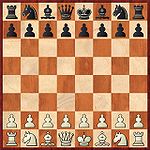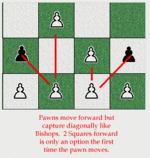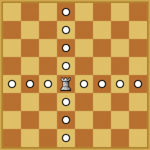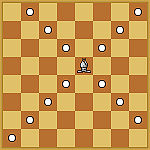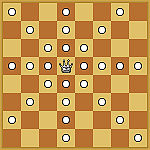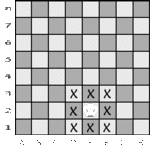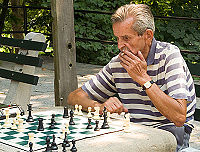From The Peopling of New York City
Contents |
Chess
Background
Western Chess began 1500 years ago during the 6th century. Before the game was established as "Chess", people from India started playing an earlier form of the board game. From India, it spread to Persia, the Muslim world, and eventually to Southern Europe. In the 15th century, the game evolved to what it is today. Chess did not reach America until 1641, in a book entitled "Dutch New York" by Esther Singleton. In 1786, the first of many chess writings in America was published: "The Morals of Chess" by Benjamin Franklin.
- In India: The game began in the 6th century and was called chaturanga, which means “having four limbs” alluding to the “four divisions [of the military].” Their pieces were called the infantry, present-day pawn; cavalry, present-day knight; elephantry, present-day bishop; and chariotry, present-day rook.”
- In Persia: Around 600 BCE, Persians started calling it "chaturanga chatrang" and the game became definitive. Present-day “check mate” was invented; however, it was called “Shah mat!”, or “the king is finished.” The Persians also invented present-day "check” which they called “Shah!”- Persian for "king". This implied that the king was under attack; however, there were moves invented that could save the king.
After the Islamic conquest of Persia, between 644-651 BCE, chess began to spread to the Muslim world. For the most part, Muslims maintained the Persian vernacular. However, Muslims changed the name to shatranj.
In early chess the pieces moved as follows- look below to see the movement of the modern-day pieces:
1. The King moved the same as it does now.
2. The Queen only moved one square diagonally.
3. The Bishop:
- a. In India: two squares either sideways or front and back. You are allowed to jump over a piece in between.
- b. In Persia: two squares diagonally. You are allowed to jump over a piece in between.
- c. In Southeast Asia: Either one square diagonally or one square forward.
4. The Knight moved the same as now.
5. The Rook moved the same as now.
6. The Pawn only moves one square forwards or diagonally forwards.
Between 1475 and 1500, the movement of the Queen and the Bishop began to expand. This form began being called “Queens Chess” or “Mad Queen Chess” in various languages including: Spanish, Portuguese, Italian, and French. This allowed players to win in fewer moves and accentuated the importance of the moves of the pawns.
During the mid-19th century, tournaments were played; in 1843, the first American chess tournament was held in NY. During the 20th century, the World Chess Federation (FIDE) was established. Now, in the 21st century, we are able to play chess online.
Today, traditional chess is at a risk of "dying out." Daaim Shabazz PhD says chess is not dead in "Is Chess Dead?"; however, it becomes increasingly more complicated to raise enthusiasm about traditional chess when there are so many engaging exciting games, besides chess, that are easily played on the internet. As a result, membership of chess clubs are dwindling.
How To Play
The goal of chess is to checkmate or threaten your opponent's king piece. Each game begins with each player having 16 pieces consisting of, a king, a queen, two bishops, two rooks, two knights, and eight pawns. Arranged as shown in the following image.
Each of the different pieces has its own unique way of moving across the board.
The Pawn can only move one space at a time. It can only move forward yet it cannot attack the space in front of it. Instead it can only attack the two spaces that are diagonally in front of it, one on the left and the other on the right.
The Rook can move as many spaces as it can before hitting another piece. It can move either vertically or horizontally and unlike the pawn, it can attack the opponent's pieces the same way.
The Knight moves differently from the other chess pieces because instead of moving on one axis, it moves on two. The Knight starts its move by moving two space along either of its axis (vertical or horizontal but not the diagonal) and then one space in either direction along the other axis.
This Bishop moves only along its diagonal axis. It can move as many spaces as it wants until it hits another piece.
The Queen is traditionally thought of as the most powerful piece in chess. It can move as a combination of the Rook and Bishop, giving it the ability to move as many spaces as it wants along its, vertical, horizontal, or diagonal axis, until it hits another piece.
The King is the most important piece in Chess. Once it has been "mated" the game is over. However it is very limited in how it can move. It too can move like the queen but only one space, giving it the ability to move one space in any direction.
The Eastern European Culture of Chess
In Eastern Europe, chess is viewed as a test of a person's mental capacities. Chess players in Europe are proud of their skills. In many of the former Soviet Republics chess was viewed almost as a sport would be, with each player being ranked and then competing among peers of his own level as he gradually advances in skill.
A common trend that came out of Eastern Europe is the idea of the family chess teacher. This is the most common way to learn the game in these countries- through family games with grandfather or father; they would pass on their knowledge of the game to their children and grandchildren.
The game has also followed these people as they immigrated to America. It is very common to see elderly Russian or Ukrainian immigrants playing chess in Brighton Beach. America has not changed the game itself, but has in a sense, altered its value. Second generation immigrants are more Americanized and, therefore, not as familiar with the game. Although some of them are still taught by their parents, it doesn't carry the same weight as it would in the home country. However, the elderly still retain their knowledge and use the game as an occasion for gathering, where they can pass their time while still challenging each others' mental faculties. In a sense, chess has become more important for elderly "Slavic" immigrants here, than it has in their country of origin because of a need for such an outlet to socialize and feel connected to others who come from the same place and share the same experiences as they do. As such, games serve mainly as a backdrop for conservation. Walking by such a game, an observer might hear playful banter and obnoxious trash talk and accusations of perpetual cheating, or just talks about the well-being of relatives.
Chess in New York City
Chess in New York has taken on a life of its own. It is a game that can be found in many of the parks and playgrounds that are scattered throughout the city. There are numerous schools where a person can learn the game and become a master of it. New York is a city that has fully embraced chess as a part of itself.
Demographics
Western style chess is truly a game without borders. In America today, there are many people from completely different backgrounds who play chess. This is in large part due to the structure of American immigration. America began as a refuge for immigrants from Western Europe. European immigrants represented the largest group of immigrants dating back to America's founding; only overtaken by Asian immigrants in the 1980's. As such, these people had a great impact on the culture that eventually became "American." They brought with them bits and pieces of their culture, including the game of chess.
Today we live in a world that is many generations removed from the founders of America. Yet they, and the people who came after them, created the world we live in now. Chess has become a large part of that culture. Today whether or not a person will learn the game of chess is not solely determined by the their ethnic background, but more by the person himself. Chess has become a readily available part of American culture and so, if someone wants to, they can learn. Recently I went to Chess NYC, a chess school located in the West Village and was very surprised at the diversity that i saw there. After talking to some of the players there, I quickly realized that chess has truly become an American tradition. Luis Mendoza was a second generation immigrant from the Dominican Republic and he had learned to play from his grandfather as a child. The same was true of Paul Miley, a New Yorker who joked that his family had been here "ever since the revolutionary war, and probably even before that."
Some immigrant cultures favor chess, while others don't. In New York City, chess has become such a staple of the American culture that it doesn't matter where you are from, someone from your community plays chess.
Chess in Brighton Beach
Brighton Beach is currently home to a large population of first and second generation immigrants from the former Soviet Union. Together these people gathered in this area that became known as Little Odessa, named after the city in present day Ukraine from which many of the immigrants came. The name also comes from the uniquely Russian feel that the area brings with it. The storefronts along Brighton Beach Avenue are littered with Russian shops and restaurants, all of which have more Russian writing on them than English. This is an area where the immigrants have done their best to keep their culture alive, and one part of that culture is chess.
A block away from Brighton Beach Avenue is Seaside Park, a place well known around the area for its concerts and playground, but also for the chess that people play there. Though not usually very crowded before the summer months, Seaside Park has its resident population of chess players who stay all year round. These people are mainly elderly Russian immigrants who learned the game of chess back in the Soviet Union and brought it here, where it reminds them of the life that they left behind. When asked how long they have been playing this game, a common answer was "since childhood," or "I grew up with chess, either in school or at home." In Russia, chess is a popular game and a large part of the population knows how to play. Oleg Semonov from Moscow, 70 years old, said that, "My wife always asks me why I always go out, even when its cold to play. I always answer her that even though my opponents there aren't very good (glancing over at his recently beaten opponent Alex Melnekov who just muttered under his breath 'you got lucky'), I've been playing ever since college so why would I give it up now."
Chess for the elderly Russian population of Brighton Beach symbolizes a way to keep the mind sharp, as well as just something to help pass the time. Alex Melnekov, from Sevastopol, also around 70 years old, said, "It used to be that my family took up most of my time. Either I was at work or just doing something else I was always busy. Now we came to America and I quickly realized that my family had moved, split a little bit more than I would have liked. So I play chess." It turns out that the two had been friends ever since coming to America, and chess was part of their weekly ritual . This is a common occurrence in Brighton Beach, and though not everyone plays several times a week or even at all, it is still a very popular way to spend your day, and test your mind against someone else.
Famous American Chess Players and Their Origins
As you can see, the majority of famous American chess players have some sort of immigrant decent, whether they are first or second generation immigrants. Here are brief biographies of a few noted famous chess players in American chess history:
- Frank Marshal was born in New York City; however, he moved to Montreal, Canada where he began to play chess. He soon became one of the leading players in Montreal. In 1924, he was the first American to defeat a Soviet player in the international competition.
- Bill Lombardy was born in the United States; he later became the first American to win an official world chess championship in 1957.
- Maurice Ashley was born in St. Andrew, Jamaica. Interestingly enough, he is the first and as of 2009 only African-American grandmaster.
- Bobby Fischer was born in Chicago, Illinois. At the age of 14, Fischer won the US Chess Championship in 1957/1958. He created a variant of chess called Fischer Random, which puts little emphasis on the first move each player makes. There is a Fischer Random Generator to generate the first move of each competitor.
- In 1963, Walter Harris became the first African-American master. He was a New York native. He also played in the U.S. Open in 1959.
- Hermann Helms was born in Brooklyn, New York but raised in Hamburg, Germany and Halifax, Canada. In Hamburg and Halifax, Helms learned how to play chess. He became the first Dean of American Chess.
- Yassar Seirawan was born in Damascus, Syria. He, later, became the first American to beat a reigning world champion (Karpov) in 1982.
- Samuel Rehshevsky is considered one of the leading American Chess Grandmasters. He won the chess tournament in 1969 and 1972. He was born in Poland in 1911 and moved to New York in 1922. He learned to play at the age of four. Interestingly enough, he was an Observant Jew and did not play on the Sabbath, all of his games were scheduled accordingly.
Personal Experience with Chess
After interviewing Steven Winfield, my father, I found an interesting trend regarding the role of immigration in chess playing. Steven Winfield was taught how to play chess at the age of four and a half by a friend of his immigrant mother, who was also an immigrant from Europe. At the age of six, he beat his Hungarian father at chess, who was well known for his chess skills within his community. At the age of seven he was beating all of his father's friends. At the age of nine he was chess champion of his age group in Oak Park, Michigan.
You may ask: how did he get so good at chess? Europeans are very big on chess. Whenever his parents would get together with friends, they would play chess. He just started by watching them play, then they let him play, and finally he began winning. After beginning to immerse in the game, he took out books from the library that were written by chess grandmasters. He would first read the book, and then he would play out the game that was written in the book. His favorite chess master was Sammy Reshevsky from Poland.
Interestingly enough, on a vacation with his parents to the Catskills, he played against Sammy Reshevsky. Mr. Reshevsky was brought in to play numerous simultaneous chess games as a form of entertainment. Dr. Winfield would play chess whenever he could. His teacher in school, whose parents were European, would challenge him to a chess game during recesses. His classmates loved him because the teacher would not stop playing until the game was over thereby extending recess.
In Steven Winfield’s experience most children with American born parents did not play chess whereas most children with European born parents did play chess. Perhaps this is because of the difference in lifestyles. The immigrants did not have money or electronics such as: television, radio, or cars so they played chess. Chess is a game that does not cost much money and provides hours of intellectual entertainment.
